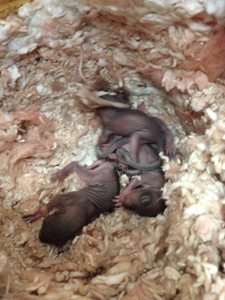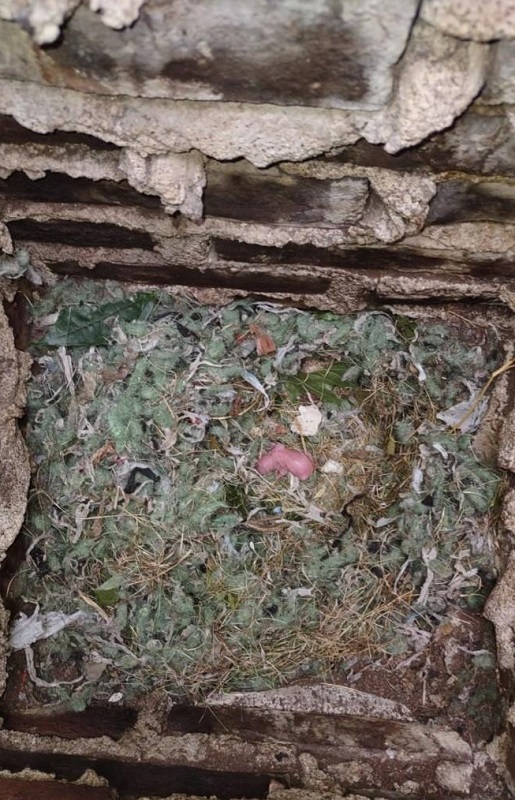
Squirrels are the most common tree-dwelling rodents in the U.S., with at least one species residing in all 50 states. You can find them nearly everywhere, from city parks and suburban gardens to remote forests. These little creatures give birth to even tinier hairless babies, usually weighing just 0.5 to 0.65 ounces each, in litters of two to four. The baby squirrels rely entirely on their mother’s care for up to 12 weeks. At the four-month mark, the baby squirrels strike out on their own, fully furred and capable of surviving independently.
If you find a baby squirrel on your property that isn’t old enough to be independent, especially one that seems orphaned or injured, it’s important to proceed with caution. Wild animals, including squirrels, can be unpredictable under stress or fear, so improper handling can be dangerous for the person and the animal. In these cases, it’s best to contact a professional wildlife service, like Critter Control, which specializes in the humane removal of adult and baby squirrels from homes and businesses.
Need Help with Squirrel infestation?
Find a Critter Control near you.
When Do Squirrels Have Babies?
Squirrels have two breeding seasons each year: midsummer and late winter or early spring. Since the first litter of baby squirrels is born in the chillier seasons, mother squirrels often seek a cozy, warm, and protected place to raise their young. Unfortunately for you, the attic and other protected areas in your home and business are quite appealing for squirrel rearing.
How Many Babies Do Squirrels Have?
Squirrels usually give birth to small litters containing two to four pups. Each litter can contain up to eight pups or as little as a single pup, but litters with two to four pups are most common.
What Do Squirrel Nests Look Like?
In the wild, squirrel nests, called dreys, are woven of various materials and look sort of like bird’s nests. Squirrels forage for twigs, leaves, moss, and other natural materials readily available in their environment. Once they find their materials, they cart them up to their nesting place, carefully constructing the nest in the desired location.
However, if the opportunity arises, they’ll happily use soft materials they can find in your home. For example, if they shimmy into your attic, they might use your home’s insulation as a prime nesting spot, which, unfortunately, can leave a trail of costly damage.
What Do Baby Squirrels Eat?
For 10 to 12 weeks, baby squirrels eat and drink only their mother’s milk. Once developed, pups leave the nest and begin to forage for nuts, grains, and berries. Weaned juveniles mature and multiply quickly. Female squirrels are ready to reproduce within their first year.
What Do Baby Squirrels Sound Like?
Adult squirrels can be noisy. The rodents will bark if threatened and chirp during mating season or territory disputes. Although quieter, their pups still make noises. When stressed or hungry, baby squirrels sound like young birds due to their soft, high-pitched chirping.
What Do I Do if I Find a Baby Squirrel?
Baby squirrels are helpless creatures for the first few weeks of their lives, and if orphaned or injured, they may not survive. So, if you find a baby squirrel on your property, it’s important to follow the correct steps to ensure your and the squirrel’s safety:
- Assess the situation: Evaluate the baby squirrel to determine if it’s injured or appears abandoned. Sometimes, mother squirrels temporarily leave their young unattended while gathering food but will return shortly. If the baby squirrel looks healthy and uninjured, leave it where it is for a few hours, watching to see if the mother returns.
- Avoid handling: Wild animals, including baby squirrels, can carry diseases, and improper handling can stress the animal. So, while the baby might be adorable, it’s best to avoid touching it.
- Contact a wildlife professional: If the mother doesn’t return or the baby is injured, contact a wildlife veterinarian or rehabilitator. If the squirrel is uninjured, reach out to a professional wildlife removal service like Critter Control. This way, you can rest assured knowing the baby and the rest of its family are safely and humanely removed from your property to thrive in a more suitable spot.
How Do I Remove a Baby Squirrel?
When an adult squirrel deems your home or business prime real estate for parenting, you might end up with an influx of baby squirrels.Squirrels in attics, squirrels in wall cavities, and those that use insulation for nesting can leave all sorts of damage in their wake. While warm, dry, and safe, each location can present an issue for raising baby squirrels. For example, baby squirrels can fall into wall voids, distressing both mother and baby and leading to a potentially dangerous situation for home and business owners.
If you’re dealing with a squirrel intrusion, you mustn’t attempt to remove them on your own. Baby squirrels depend highly on their mothers, so their survival chances are slim when they’re away from her. Plus, squirrels can carry diseases and bacteria, which you may come into contact with during removal.
Furthermore, since they are wild creatures and won’t know that you’re trying to evict them safely from your home or business, you might add to the squirrels’ damage to your insulation and structure. So, it’s best to enlist the help of the pros to relocate squirrels and their babies.
Baby Squirrel Prevention & Exclusion
Preventing baby squirrels from taking up residence in your home starts with the adult squirrels. If the adults can access your home, they may build their nests inside it. Here are a few ways to keep squirrel home damage from becoming a problem:
- Keep your yard clean and free of fallen nuts, acorns, and birdseed to avoid attracting squirrels.
- Seal entry points, including holes, gaps, or weak points (especially around the roofline), where squirrels might sneak through.
- Keep trees and shrubs around your home trimmed since squirrels in trees overhanging your roof can easily access the upper portions of your home.
- Install chimney caps and vent covers to prevent squirrels from entering through those points.
- Have a professional wildlife service, like Critter Control, inspect your property regularly to ensure you don’t have unwelcome houseguests.
Contact Critter Control for Humane Squirrel Removal
If you find baby squirrels and their families residing in your home, our experienced team at Critter Control is here to help. We’re well-versed in safely and humanely removing squirrels, ensuring they don’t start an infestation by reproducing rapidly inside your attic (or a similar area). Contact us today or find an office near you to get assistance with humane squirrel removal.

Did you find a baby squirrels in your attic?
Find a Critter Control near you

Get them out.
Keep them out.®
Experiencing a wildlife or pest issue? We can help! Complete this form and your local Critter Control® office will contact you to assist.
- How to Get Rid of Squirrels
- Squirrels Entering Homes
- Squirrels in Attics
- Squirrels in Chimneys
- Squirrels on Roofs & in Soffits
- Squirrels in Walls
- Squirrels in Ventilation
- Squirrels in Gutters
- Squirrels in Crawl Spaces
- Squirrels in Yards or Gardens
- Squirrels in Trees
- Squirrels Digging Holes in the Ground
- How to Identify Squirrel Sounds
- Squirrel Tracks
- Squirrel Droppings
- Squirrel Trapping
- Squirrel Repellents & Deterrents
- Squirrel Appearance & Identification
- Species & Types of Squirrels
- Squirrel Life Cycle
- Squirrel Nest
- Dead Squirrels
- Squirrel Diet
- Diseases That Squirrels Carry
- Rabid Squirrels
- Do Squirrels Hibernate?
- Gray Squirrels
- Do Squirrels Bite?
- Squirrel Damage to Your House
- Squirrels vs. Rats
- Squirrels vs. Chipmunks